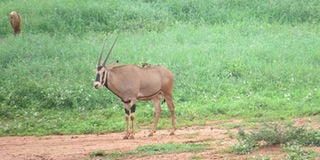Expert raises alarm over declining wildlife numbers

An oryx grazing at Tsavo West National Park. PHOTO | FILE | NATION MEDIA GROUP
What you need to know:
- Illegal cattle grazers in game reserves have increased by more than 1,100 per cent.
- By 2013, seven wildlife species across Kenya were classed as critically endangered, 19 as endangered and 37 as vulnerable.
A scientist has sounded the alarm over declining wildlife populations in Kenya.
The Thomson’s gazelle, warthog and oryx among others are under severe threat, and they have declined by more than 70 per cent.
Numbers of Grevy’s zebra and waterbuck have fallen lower than 2,000, putting them among species whose future viability is under extreme risk.
Dr Joseph Ogutu, a senior statistician in the Bioinformatics unit of the University of Hohenheim in Germany, attributed this to the increasing numbers of livestock and human populations, and climate change.
Dr Ogutu has been studying aerial surveys of Kenya’s wildlife between 1977 and 2018.
The data was gathered from aerial observations conducted by the Directorate of Resource Surveys and Remote Sensing of Kenya.
GRAZING PRESSURE
According to the study published in Earth and Environment journal, illegal cattle grazers in game reserves have increased by more than 1,100 per cent.
Overgrazing, which causes the degradation of forage resources, is also having a significant impact, according to Dr Ogutu.
The study revealed that nearly 70 per cent of Kenya’s wildlife population occurs in private or community areas away from the protection of national parks and game reserves.
"This leads to conflict when crops get trampled or eaten by animals, or when there is a risk of disease transmission to livestock or humans," the study says.
“While cattle numbers have also decreased, those of sheep and goats have seen massive growth by more than 76 per cent over the study period.
"It is likely that this increase in livestock is putting added grazing pressure on land that is shared with wildlife, restricting their access to resources and cover.
“Continually growing human populations and agricultural expansion is putting more pressure on the environment, with dire consequences for both flora and fauna. He said despite numerous resources and great effort being put into conservation, wildlife declined by around 68 per cent in under 40 years."
CLIMATE CHANGE
In addition to the severe overall rates of decline between 1977 and 2016, some species were seen to decline by as much as 88 per cent.
By 2013, seven wildlife species across Kenya were classed as critically endangered, 19 as endangered and 37 as vulnerable.
In addition, 44 ecosystems or areas are currently (2018) classed as endangered.
On the other hand, the number of camels have been on the rise, which Dr Ogutu attributed to their ability to adapt to the increasingly harsh conditions seen throughout Kenya, making them popular among livestock owners looking to cope with the effects of climate change.
Temperature changes have been noted in 21 rangeland counties.
SOLUTION
This persistent change in climate has led to frequent occurrences of intense droughts in these areas, further exasperating habitat destruction and fragmentation.
Dr Ogutu said unless drastic improvements are urgently made, the loss of animals is expected to continue to escalate.
“With the country’s biodiversity at stake, it is vital we understand what is contributing to this loss so that improvements can be made,” Dr Ogutu said.
He said the introduction of The Wildlife Conservation and Management Act in 2013 in Kenya offered a glimmer of hope.
However, several gaps in the Act still require attention if any real progress is to be made.




